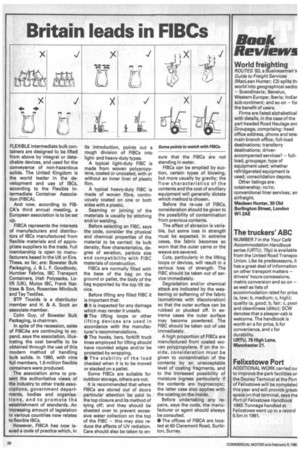Britain leads in FIBCs
Page 30

If you've noticed an error in this article please click here to report it so we can fix it.
FLEXIBLE intermediate bulk containers are designed to be lifted from above by integral or detachable devices, and used for the conveyance of non-hazardous solids. The United Kingdom is the world leader in the development and use of IBCs, according to the Flexible Intermediate Container Association (FIBCA).
And now, according to FIBCA's third annual meeting, a European association is to be set up.
FIBCA represents the interests of manufacturers and distributors of IBCs manufactured from flexible materials and of appropriate suppliers to the trade. Full membership is open to manufacturers based in the UK or Eire. These, so far, are: Bowater Bulk Packaging, J. & L. F. Goodbody, Humber Fabrics, IBC Transport Containers, Irish Polysacks, Lolift (UK), Mulox IBC, Frank Nattrass & Son, Rosenlew Minibulk and Tay Textiles.
BTP Tioxide is a distributor member and H. & A. Scott an associate member.
Colin Guy, of Bowater Bulk Packaging, is chairman.
In spite of the recession, sales of FIBCAs are continuing to expand, says the association, illustrating the cost benefits to be obtained through the use of this modern method of handling bulk solids. In 1980, with nine full members, 1.6 million flexible containers were produced.
The association aims to present the authoritative views of the industry to other trade associations, government departments, bodies and organisations, and to promote the establishment of standards. An increasing amount of legislation in various countries now relates to flexible IBCs.
However, FIBCA has now issued a code of practice which, in its introduction, points out a rough division of FIBCs into lightand heavy-duty types.
A typical light-duty FIBC is made from woven polypropylene, coated or uncoated, with or without an inner liner of plastic film.
A typical heavy-duty FIBC is made of woven fibre, continuously coated on one or both sides with a plastic.
Seaming or joining of the materials is usually by stitching and/or welding.
Before selecting an FIBC, says the code, consider the physical and chemical properties of the material to be carried: its bulk density, flow characteristics, degree of aeration, particle size and compatibility with FIBC materials of construction.
FIBCs are normally filled with the base of the bag on the ground or pallet, the body of the bag supported by the top lift device.
Before lifting any filled FIBC it is important that: • It is inspected for any damage which may render it unsafe.
• The lifting loops or other lifting devices are used in accordance with the manufacturer's recommendations.
• The hooks, bars, forklift truck tines employed for lifting should have rounded edges and/or be protected by wrapping.
• The stability of the load checked when it is to be moved or stacked on a pallet.
Some FIBCs are suitable for outdoor storage, others are riot.
It is recommended that where FIBCs are stored out of doors particular attention be paid to the top closure and its method of tying off; and they should be sheeted over to prevent excessive water collection on the top of the ABC — this may also reduce the affects of UV radiation. Care should also be taken to en sure that the FIBCs are not standing in water.
FIBCs can be emptied by suction, certain types of blowing, but more usually by gravity; the flow characteristics of the contents and the cost of ancillary equipment will generally dictate which method is chosen.
Before the re-use of FIBCs, consideration should be given to the possibility of contamination from previous contents.
The affect of abrasion is variable, but some loss in strength must be expected. In extreme cases, the fabric becomes so worn that the outer yarns or the weave are severed.
Cuts, particularly in the lifting loops or devices, will result in a serious loss of strength. The FIBC should be taken out of service immediately.
Degradation and/or chemical attack are indicated by the weakening or softening of the fabric (sometimes with discoloration) so that the outer surface can be rubbed or plucked off. In extreme cases the outer surface may become powdered. The FIBC should be taken out of use immediately.
A high proportion of FIBCs are manufactured from coated woven polypropylene. If on the inside, consideration must be given to contamination of the contents by an unacceptable level of coating fragments, and to the increased possibility of moisture ingress particularly if the contents are hygroscopic; the latter case also applies with the coating on the inside.
Before undertaking any repairs, says the code, the manufacturer or agent should always be consulted.
• The offices of FIBCA are located at 60 Claremont Road, Su rbiton, Surrey.












































































































